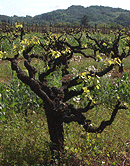|
Wineries
Wines
More Info. |

Storing
and Aging Wine Some of the most frequent
questions I'm asked concern the storage of wines.
With proper storage, many wines improve with age.
On the other hand, improper storage can ruin a good
wine in a day. Wines meant for consumption within a
few weeks should be kept cool and out of direct
sunlight. The following are some general guidelines
regarding the storing and aging of
wines: Temperature is the
most important factor in successfully storing
wines. Wines that get too cold can freeze or expand
to the point that the cork is pushed from the
bottle. Wines that get too warm (over 77 or 78
degrees Farenheit) will "cook" and degrade the
wine. The optimal temperature for cellaring wine
for long-term storage is 50 to 59 degrees Farenheit
(10 to 15 degrees C). In theory, the colder the
temperature, the slower the aging process,
therefore a wine stored at 50 degrees will age
slower than one at 58 degrees. It is also very
important to maintain a constant temperature, as
fluxuations can affect the aging
process. Humidity is also a
factor. Low humidity can dry the cork to the point
that oxygen can seep in and come in contact with
the wine. The ideal relative humidity is
approximately 75 per cent. Position is important
too. It is important for wine to be in contact with
the cork so that the cork does not dry out, thus
allowing oxygen to come in contact with the wine.
Stored wine bottles are normally kept in a
horizontal position, although many wineries store
and ship bottles in an inverted position. Shock or
agitation to aging wine bottles can disturb the
sediment and affect the aging process. Sunlight can also
affect the aging process. It is important to keep
wines out of direct sunlight, which is one reason
many wines, especially reds, are distributed in
tinted bottles. As such, white wines are usually
the most susceptable to sunlight. Wine
Storage Summary Temperature 50 to 59 degrees
F Relative
Humidity 75
percent Position of
Bottle Horizontal or
Inverted Lighting No Direct
Sunlight Storing
Open Wines A wine's flavor will rapidly
degrade with prolonged contact with air, therefore
the storage of wine after it is opened must be
accomplished by limiting air contact. The most
effective way is to transfer the wine to a smaller
bottle. Most premium wine bottles contain 750 ml of
wine whereas many dessert wines are sold in 375 ml
bottles. Transferring a half-bottle of open wine to
a clean 375 ml bottle (filling as much as possible)
is the preferred method. Vacuum wine savers are
available that consist of a vacuum pump and bottle
cap with a valve. Placing the cap on the bottle and
removing the air from the bottle will minimize air
contact, however I have found that the seals
deteriorate with age. I recommend the nitrogen gas
cylinders from which you inject a small amount of
nitrogen into an open bottle of wine and then seal
with the original cork. The nitrogen does not
affect the taste of the wine and prevents the
contact of oxygen. These devices usually cost
between $10 to $15 and can preserve from 50 to 100
bottles, depending on the size. Long-term
Storage and Aging Not all wines will benefit
from long-term aging. In fact, most wines produced
are meant to be consumed within a year of the
bottling date. White, sparkling, sweet blush,
Nouveau and red table wines are less
affected by aging and should be consumed in a
relatively short time-- usually within six months
from bottling. Red wines with high tannins and
concentrated flavors are generally more affected by
the aging process. In general, Cabernet Sauvignon
and Syrah will generally age more effectively than
a Merlot or Pinot Noir. Aging
of Varietal Wines Aging in Years Cabernet
Sauvignon 4 to
20 Merlot 2 to
12 Nebbiolo 4 to
20 Pinot
Noir 2 to
8 Syrah 4 to
16 Zinfandel 2 to
6 Chardonnay 1 to
6 Riesling 2 to
30 Semillon (Dry
Wines) 2 to
7 |
|||||||||||||||||||||||||||||||||||||||||||||||||||||
